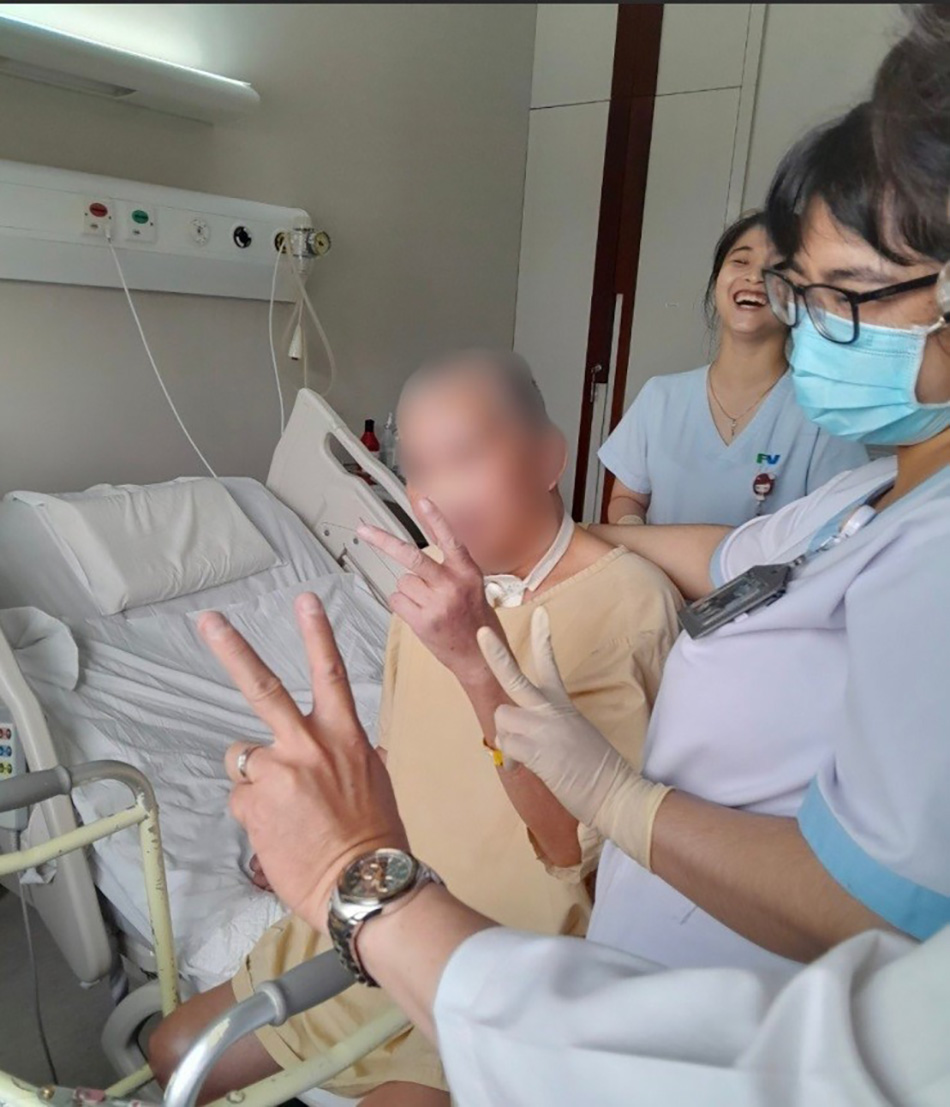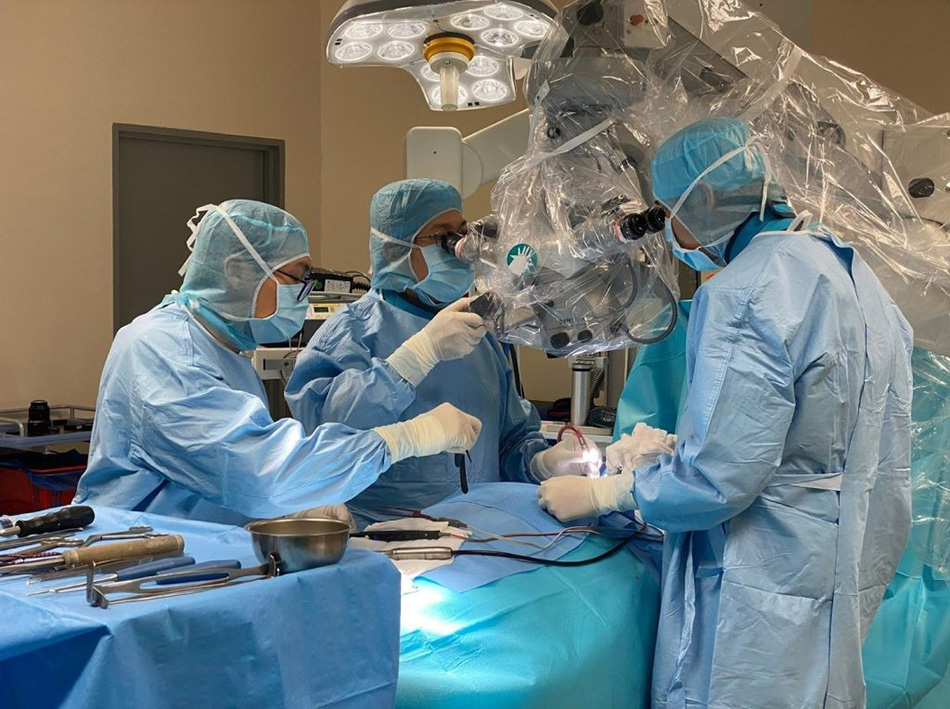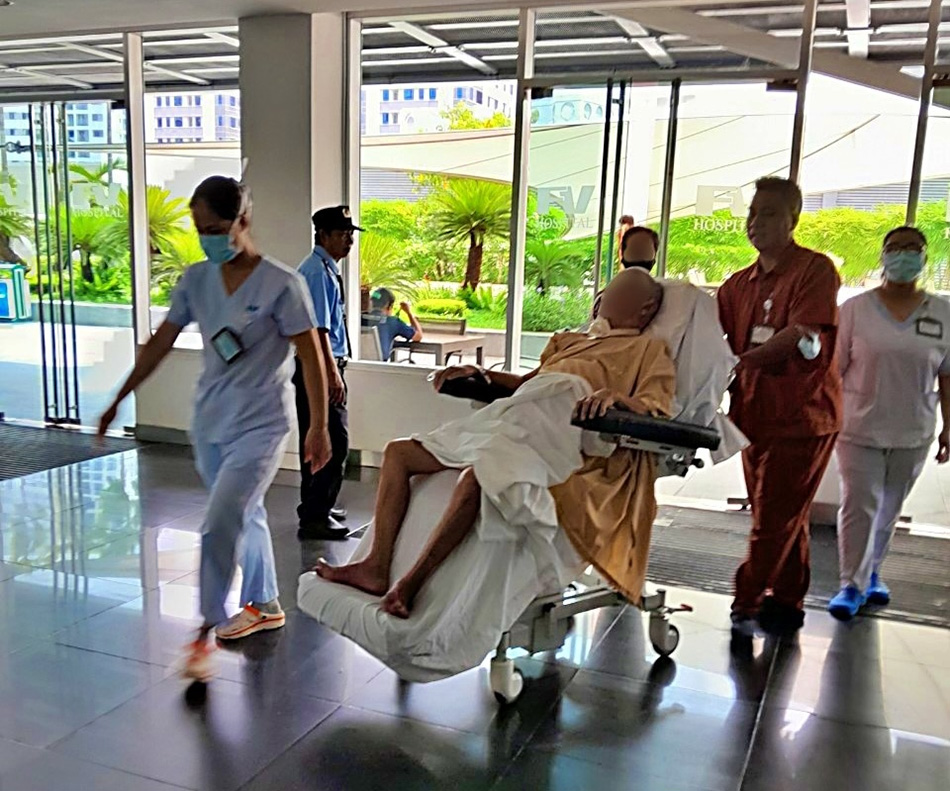A 67-year-old patient, who had suffered a traumatic brain injury from a fall that resulted in a deep coma and severe infection, was sent away by several hospitals but made a remarkable recovery after 80 days of treatment at FV Hospital.

From a vegetative state, patient has now regained the ability to sit up and interact with the medical staff.
The journey to regain life for Mr P.D.V. (67 years old, from Khanh Hoa) involved tremendous effort from the entire medical team at FV Hospital, along with the unwavering belief of his wife.
The journey of seeking a chance at life
While climbing onto the roof to fix some electrical issues, Mr V. fell and lost consciousness. At the local hospital, doctors performed a craniotomy to relieve pressure on his brain but despite the surgery, Mr V. remained in a deep coma…unresponsive to his surroundings.
His family decided to transfer him to a higher-level hospital in Ho Chi Minh City. However, due to the severity of his condition, Mr V. was to be moved between multiple hospitals, with many refusing to treat him as they saw no viable treatment options. Some even advised the family to prepare for his passing.
Thinking of her husband, who had worked tirelessly for the family and had yet to enjoy a peaceful retirement, Mrs P. couldn’t bear to give up. In her moment of despair, she was introduced to FV Hospital, where she sought treatment with the hope that “as long as there’s life, there’s hope.”
Dr Nguyen Manh Hung, Head of Neurosurgery and Endovascular Neurosurgery Department at FV Hospital, described Mr P.D.V.’s condition upon arrival as critical. Dr Hung explained, “The patient was completely unconscious, dependent on a ventilator, and suffering from a severe infection. He had a large skull defect, enlarged ventricles – indicating hydrocephalus – and was also suffered from bronchitis and severe malnutrition.”
Given the severe infection, the patient required intensive care to stabilise his health before proceeding with and further treatment steps.
Suporting the patient day and night, helping patient overcome the brink of life and death.
With many years of experience in caring for critically ill patients, Ms Bui Thi Na – Nurse Team Leader- Surgical East Ward at FV Hospital shared her deep concern when taking on this case, as she saw how slim the chances of survival were for the patient.
The nurses took turns to stay by the patient’s side 24/7, with 2-3 nurses per shift, working alongside the doctors to fight for the patient’s life. “The patient was curled up, unconscious, with phlegm bubbling in his throat. Seeing his wife, who was frail and devastated but still determined and hopeful to save her husband, I encouraged my team to do their best,” she recalled.
Ms Na said she seemed to “hold her breath” while monitoring the patient’s progress. She felt a sense of relief when she received news that the patient’s phlegm volume had reduced each day and the infection was improving. Though the signs of recovery were slow, the patient was gradually moving away from the brink of death.

A model simulating the skull piece that needs to be reconstructed for the patient
After two weeks of intensive care, Dr Hung assessed that the patient was ready for skull reconstruction. ‘The patient’s skull had been removed during the initial surgery. According to principles, once the brain has stabilized, a skull is needed to cover and protect it; otherwise, brain function may be affected. However, due to inadequate transport and preservation of the skull piece from Khanh Hoa to Ho Chi Minh City, the team decided to use a prosthetic skull piece for the patient,’ Dr Hung said.
The patient underwent a CT scan of the skull to accurately measure the 3D image of the skull defect area. These parameters were used to create a prosthetic skull piece that perfectly matched the size and shape of the patient’s skull defect.

Dr Nguyen Manh Hung’s team performed ventricular-peritoneal shunt surgery for the patient
Next, the doctors performed a ventricular-peritoneal shunt for the patient. Cerebrospinal fluid is the liquid that surrounds and helps protect and nourish the brain and spinal cord. In this case, there was an excess of cerebrospinal fluid, leading to increased pressure on the brain. Therefore, the team had to create a drainage route for the cerebrospinal fluid to the abdominal cavity to reduce the pressure of the cerebrospinal fluid on the brain tissue,” Dr Hung explained
Remarkable recovery following a series of days placing complete trust in the medical team
After the cerebrospinal fluid (CSF) accumulation in the brain was relieved, patient P.D.V. showed significant progress. He began to exhibit conscious reflexes, gradually regained the ability to express emotions, and even started to move his body and communicate with others.
Typically, patients who are hospitalised for an extended period face several risks, such as bedsores, infections, and pneumonia. The FV nursing staff provided meticulous care for Mr V, to prevent bedsores and reinfection. They regularly turning him and took him outside for sunlight exposure daily. Many staff members were accustomed to seeing a nursing team from the General Surgery Department pushing a patient in a wheelchair to the terrace for a walk at 10 a.m. This walk was always accompanied by essential emergency equipment, such as a resuscitation bag and an oxygen tank. “The patient’s condition was fragile and could worsen at any moment, so we always have contingency plans,” explained Ms Na.
To support the intensive treatment of the patient, doctors from various specialties, including ENT, Infectious Diseases, Dietetics & Nutrition, Neurosurgery, ICU, and Physical Therapy & Rehabilitation, coordinated, assessed, and consulted continuously to develop the optimal treatment plan. Dr Hùng emphasised that the nursing team’s care played a crucial role in Mr V’s recovery.

The surgical ward nursing team takes the patient outside for sunlight exposure every day
Nurse Na recalls that, during the early days, Mrs P was not very hopeful about FV, having gone through a long journey seeking any chance for her husband’s survival. Over time, Mrs P developed trust and placed her husband’s life in the hands of the FV medical team. Even when her husband was ready to be discharged, she hoped he could stay longer to receive continued care until he was fully recovered. However, Dr Hung explained that prolonged hospitalisation is not ideal and that an outside environment, especially the family setting, is necessary for the patient’s recovery.
Before leaving the hospital with her husband, Mrs P emotionally held the hands of the nurses who had cared for every meal and sleep of her husband over the past 80 days. “Witnessing the patient go from a seemingly hopeless condition upon admission to being discharged with a healthy complexion was truly moving,” Nurse Na recalled with emotion.
According to Dr Hung, at the time of discharge, the patient was able to stand and move with assistance, and importantly, he could think and communicate with others. The next steps involve adhering to a physical therapy regimen and following a suitable diet for recovery. Dr Hung continues to support the patient’s care remotely.
“This was a very difficult and challenging case both in treatment and care. When the patient arrived, it was a chaotic situation in terms of treatment schedules, paperwork and technical aspects, all with a fragile hope for survival. But seeing the patient recover is a happiness not only for the family but also for our medical team,” shared Dr Nguyen Manh Hung, Head of Neurosurgery and Endovascular Neurosurgery Department at FV Hospital.



